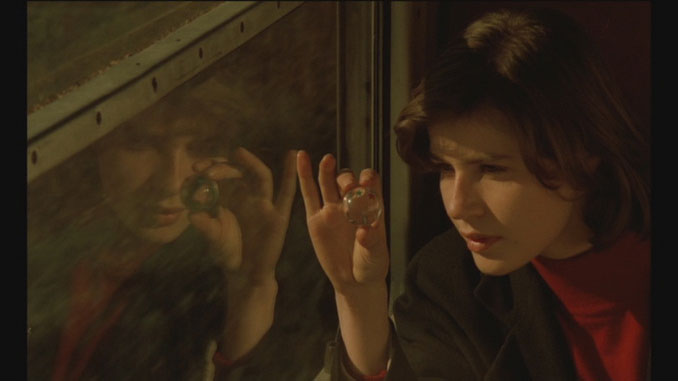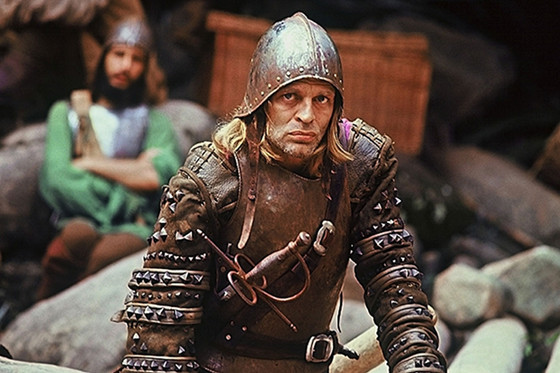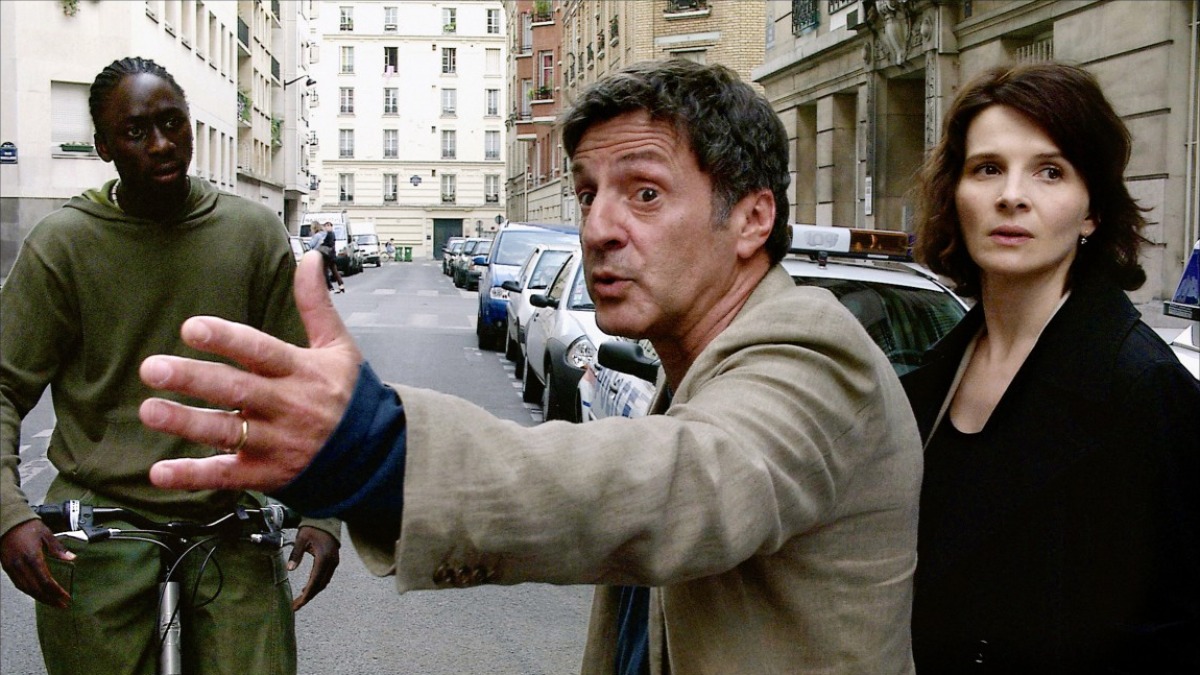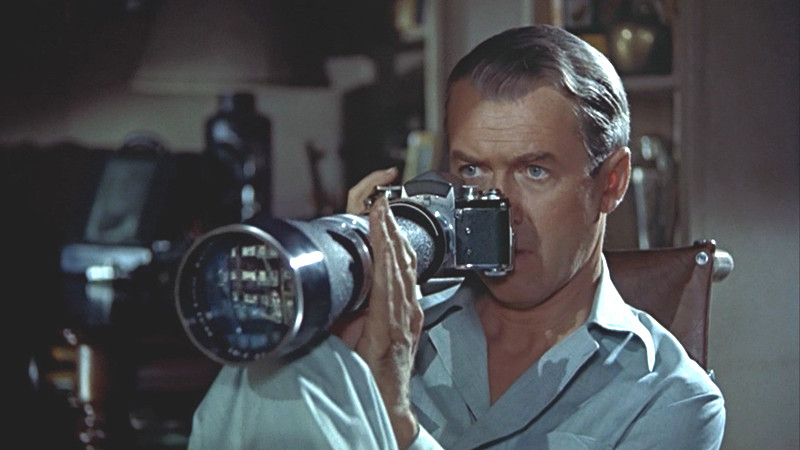6. The Double Life of Veronique (1991) – Glass Ball Illusion

The film opens on a glass ball where the audience sees an upside-down view of a mysterious skyline at night. It turns out to be the point of view of a little girl with her unseen mother speaking softly to her about the stars and leaves. It might seem simple for a film, but not for Krzysztof Kieslowski.
What we don’t realize is that this little girl is actually two; it’s first Weronika due to the Polish voiceover, then Veronique due to the French voiceover. Then we get the opening credits to an operatic choir singing and more adult versions, hauntingly played by Irene Jacob, seen through that glass ball again.
Kieslowski establishes his poetic and spiritual film in the opening and tells the whole film because all of its elements are being used, from Idziak’s cinematography to Preisner’s score. With a montage and his direction, we get a feeling of the characters and what is to follow by the music linking the images together. Of course, one cannot guess all the outputs and we truly must surrender to the film from the beginning, but Kieslowski’s use of distilled point of view and objectivity make this film soar from the opening, where we get the story even if we don’t know what it truly means or what it is.
7. Aguirre, the Wrath of God (1972) – Trekking Over Mountains

When Werner Herzog commits to a film or documentary, or sometimes one in the same, you know you’re in for something special. Here, with his best friend, Klaus Kinski, they literally trekked to the Peruvian rainforest to tell the story of Lope de Aguirre and his search for the lost city.
From the opening frames, we see hundreds of men, trekking in heavy armor and carrying supplies over the mountains. Nothing here is faked and it’s all real to Herzog’s style. Due to the low budget, the camera simply panned and followed this trek. The operatic score opening over the foggy mountains tells this insane story. We see the madness of the character, his men, and the filmmaker himself.
In true Herzog fashion, narrative and documentary combine, showing the visceral act. Notice how the score goes from enlightening to suddenly menacing and full of the unknown. Well, that’s what occurs over the duration of the film, much like Kinski and Aguirre alike.
A heavy influence on later films for characters going into the darkness as well as difficult film productions, the opening scene shows how difficult it was to make for the cast and crew, and most importantly, it tells the story behind this wrath.
8. Cache (2005) – First Video Footage

What begins as a simple static shot of a house in a Paris neighborhood turns out to be a videotape. Of course, we don’t know this until we cut to inside the house and actually see that it was a tape. But what Michael Haneke cleverly does is introduce the style, tempo, and shock value that occurs throughout the film.
Sure, the frame is completely still until the son, though unknown to us at the time, rides his bike into the frame. This shows how something can just pop up out of nowhere. Secondly, the style shows the camera not moving and Haneke sticks to this device for long takes and doesn’t move the camera unless motivated by character movement. And lastly, the tempo shows how we the audience must patiently watch what is occurring, much like what the characters of Juliette Binoche and Daniel Auteuil endure through the film.
Haneke has never falsified any of the imagery in his films, especially the opening. Sometimes, he’ll show the end or a scene that has nothing to do with the main characters. But here, with sparse action and minimalism, he commands our attention at truly watching banality until something is later discovered. And in the case of the themes such as collective guilt, attack on colonialism, and surveillance, the opening tells it all.
9. Manhattan (1979) – Voiceover Letter to Manhattan

Cue the George Gershwin music, Gordon Willis’ black-and-white photography, and Allen’s neurotic mumbles over the love letter to his city. As the music, imagery, and voiceover begin, we see different aspects of Manhattan to the changing admiration of Allen’s character Issac Davis.
Notice how Davis changes his words around to find the right ones to describe his love to New York. Of course, one knows it’s just Woody Allen being Woody Allen. But as the film progresses, Davis’ existentialism comes into play where he constantly changes his mind over what to do and whether or not to be in a relationship. Allen is telling us his characteristics, pattern of speech, and choices all without even seeing him. And with Gershwin’s score and Willis’s cinematography, it turns out to be beautiful.
And with Allen’s films comes the humor so we can hear and see the humor in the city over the course of the seasons. He even states it’s a town to be seen in New York and is set to Gershwin’s score. It’s easily one of the most notable openings in a film and Allen tells us his story and character; maybe not the plot, but who cares with this great opening.
10. Rear Window (1954) – Gazing into the apartments

It begins as a complicated (for its time) shot panning around an apartment complex from – you guessed it – a rear window. We see the neighbors performing their various acts that James Stewart will observe through the film. Just from the first glimpse of Stewart, we see the boiling sweat to the broken leg to the pictures in his home, therefore, establishing the likes of his character.
Hitchcock manages to tell the story of Stewart’s Jeff and the aspects of voyeurism. The key is the point of view from an outside perspective because what follows in this suspenseful thriller, while the character never leaves his seat, is that we peer across the hallway to the neighbors from a Brecht-like distance. Jeff, and obviously the audience, will never be able to intervene.
With Bernard Hermann’s playful score, the opening seems joyful like a hot summer day, but when Jeff answers the phone and a slightly shrill conversation ensues, it can change pace. Despite the fact that it doesn’t show the murder or even introduce the thriller elements in the film, Hitchcock’s style of camera, color, and point of view is established and continues until the end.
Leave it up to Hitch to make a playful opening of the camera panning around the neighbors to be told visually the same exact way through the film, but the tone and mood get more tense with anxiety and fear. Thus proving that the opening tells the story, but we must marvel at this film all the way to the end for the twists, turns, and climax.